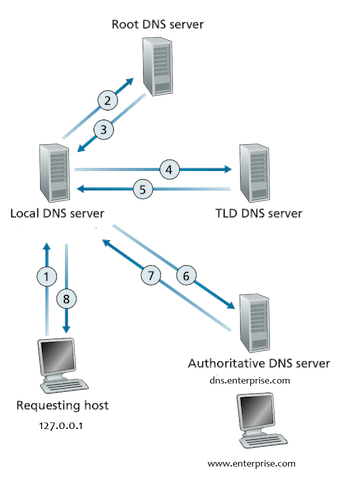DNS - Basics
Imagine that you are trying to visit www.enterprise.com, but
you don't remember the IP address the web-server is running on.
Assume the following records are on the TLD DNS server:
- (www.enterprise.com, dns.enterprise.com, NS)
- (dns.enterprise.com, 146.54.192.59, A)
- (www.enterprise.com, west5.enterprise.com, CNAME)
- (west5.enterprise.com, 142.81.17.206, A)
- (enterprise.com, mail.enterprise.com, MX)
- (mail.enterprise.com, 247.29.7.171, A)

Assume your local DNS server only has the TLD DNS server cached.
Question List
1. What transport protocol(s) does DNS use: TCP, UDP, or Both?
2. What well-known port does DNS use?
3. In the above example, how many unique type of Resource Records (RR) are there at the authoritative enterprise.com DNS server?
4. Can you send multiple DNS questions and get multiple RR answers in one message? Answer with Yes or No
5. To which DNS server does a host send their requests to? Answer with the full name
6. Which type of DNS server holds a company's DNS records? Answer with the full name
7. In the example given in the problem, what is the name of the DNS server for enterprise.com?
8. When you make the request for www.enterprise.com, your local DNS requests the IP on your behalf. When it contacts the TLD server, how many answers (RR) are returned?
9. In the previous question, there were two responses, one was a NS record and the other an A record. What was the content of the A record? Answer with the format: "name, value"
10. Assume that the enterprise.com website is actually hosted on west5.enterprise.com, what type of record is needed for this?
11. Now imagine we are trying to send an email to admin@enterprise.com, and their mail server has the name mail.enterprise.com. What type of record will contain the name of the enterprise.com domain and the name of its mailserver(s)?
12. In that MX record, what are the contents? Answer with the format: "name, value"
13. Does your local DNS server take advantage of caching similar to web requests? Answer with Yes or No
Solution
1. DNS generally uses UDP, but in some cases (such as zone transfer) it will use TCP, so the answer is: Both.
2. DNS uses well-known port 53.
3. There are 4 types of RR's: A, CNAME, NS, and MX.
4. Yes, there can be multiple 'questions' and 'answers' in a single DNS request.
5. The host first contacts the Local DNS server, which acts on behalf of the host.
6. The company's Authoritative DNS server is where their RR are stored.
7. The Authoritative DNS server for www.enterprise.com is dns.enterprise.com
8. There are 2 records returned; a NS record, and an A record for the DNS server.
9. The A record has contents: (dns.enterprise.com, 146.54.192.59)
10. In this case, a CNAME record is needed.
11. An MX record will be returned.
12. The MX record has contents: (enterprise.com, mail.enterprise.com)
13. Yes, DNS servers (especially your Local DNS server) cache records for faster retrieval.
That's incorrect
That's correct
The answer was: Both
The answer was: 53
The answer was: 3
The answer was: Yes
The answer was: Local DNS server
The answer was: Authoritative DNS server
The answer was: dns.enterprise.com
The answer was: 2
The answer was: dns.enterprise.com, 146.54.192.59
The answer was: CNAME
The answer was: MX
The answer was: enterprise.com, mail.enterprise.com
The answer was: Yes